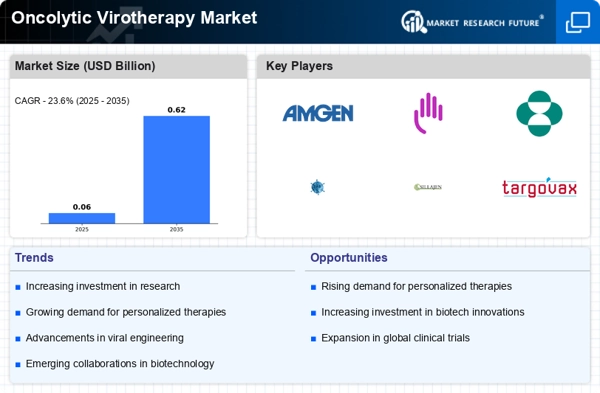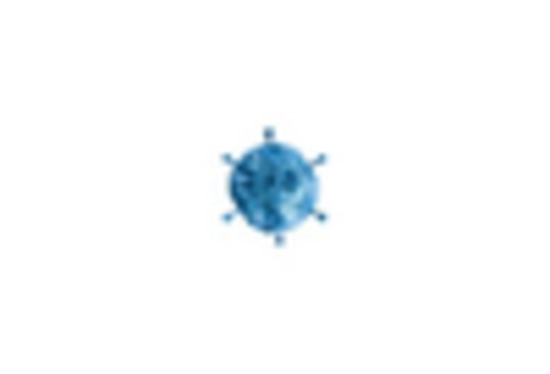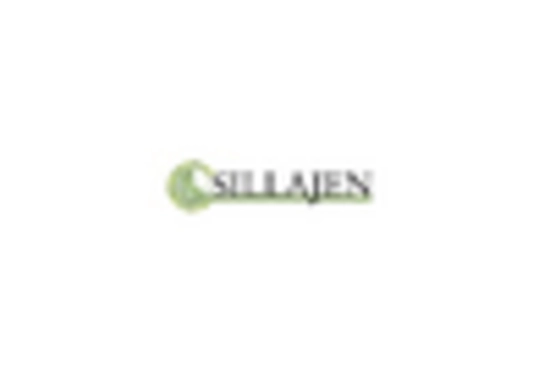Increasing Prevalence of Cancer
The rising incidence of cancer worldwide is a primary driver for the Oncolytic Virotherapy Market. As cancer cases continue to escalate, the demand for innovative treatment options intensifies. According to recent statistics, cancer is projected to affect millions annually, necessitating advanced therapeutic strategies. Oncolytic virotherapy, which utilizes genetically modified viruses to selectively target and destroy cancer cells, presents a promising alternative to traditional therapies. This approach not only aims to enhance patient outcomes but also seeks to minimize side effects associated with conventional treatments. The growing recognition of oncolytic virotherapy as a viable option in oncology is likely to propel market growth, as healthcare providers and patients alike seek effective solutions to combat this pervasive disease.
Advancements in Genetic Engineering
Technological advancements in genetic engineering are significantly influencing the Oncolytic Virotherapy Market. Innovations in gene editing techniques, such as CRISPR and other molecular tools, have enabled the development of more effective oncolytic viruses. These engineered viruses can be tailored to enhance their specificity and efficacy against various cancer types. As a result, the therapeutic potential of oncolytic virotherapy is expanding, attracting attention from researchers and pharmaceutical companies. The market is witnessing an influx of novel therapies that leverage these advancements, which could lead to improved treatment outcomes. Furthermore, the integration of genetic engineering into virotherapy is likely to foster collaborations between biotech firms and academic institutions, thereby accelerating the pace of clinical trials and product development.
Growing Investment in Biopharmaceuticals
The increasing investment in the biopharmaceutical sector is a crucial driver for the Oncolytic Virotherapy Market. As stakeholders recognize the potential of oncolytic virotherapy, funding for research and development is surging. Reports indicate that investments in biopharmaceuticals have reached unprecedented levels, with venture capitalists and pharmaceutical companies channeling resources into innovative therapies. This financial backing is essential for advancing clinical trials and bringing new oncolytic virotherapy products to market. Additionally, the competitive landscape is evolving, with numerous companies vying to establish their presence in this burgeoning field. The influx of capital not only supports the development of new therapies but also enhances the overall infrastructure necessary for successful commercialization.
Regulatory Support for Innovative Therapies
Regulatory bodies are increasingly supportive of innovative therapies, which is positively impacting the Oncolytic Virotherapy Market. Initiatives aimed at expediting the approval process for breakthrough therapies are becoming more prevalent. This regulatory environment encourages the development of oncolytic virotherapy products, as companies can navigate the approval landscape more efficiently. The introduction of fast-track designations and priority review pathways for promising therapies is likely to accelerate the time to market for oncolytic virotherapy solutions. As regulatory agencies recognize the potential benefits of these therapies, the market is expected to experience a surge in new product approvals, thereby enhancing treatment options for patients and driving overall market growth.
Rising Awareness and Acceptance of Novel Therapies
The growing awareness and acceptance of novel therapies among healthcare professionals and patients are pivotal for the Oncolytic Virotherapy Market. As educational initiatives and outreach programs proliferate, stakeholders are becoming more informed about the benefits of oncolytic virotherapy. This increased awareness is fostering a more favorable perception of these innovative treatments, which may lead to higher adoption rates. Furthermore, as patients seek alternatives to traditional cancer therapies, the demand for oncolytic virotherapy is likely to rise. The shift in mindset towards embracing cutting-edge treatments is expected to create a conducive environment for market expansion, as both clinicians and patients recognize the potential of oncolytic viruses in improving cancer care.


















Leave a Comment